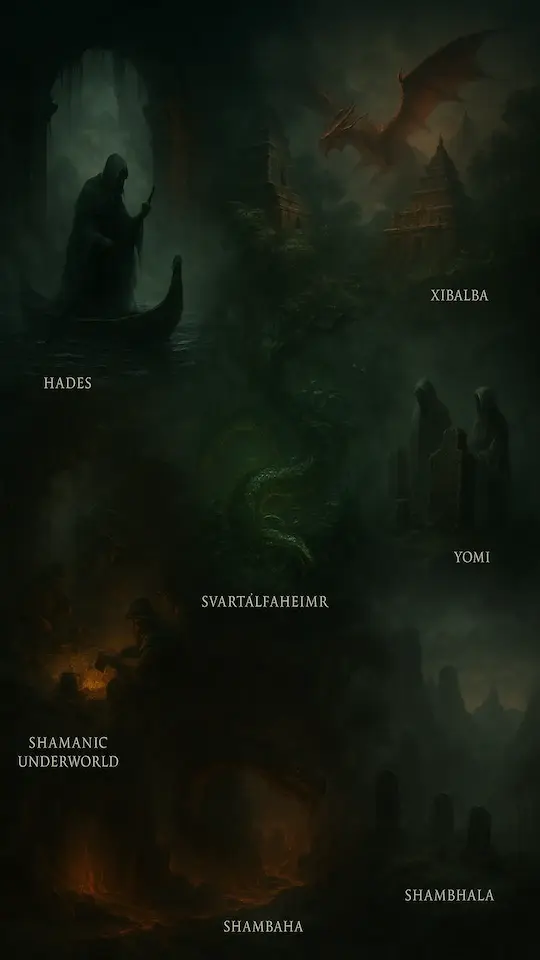Greece: Hades, the Shadowed Domain
In ancient Greek mythology, the underworld was ruled by Hades, also called Pluto. Souls crossed the River Styx with ferryman Charon, were judged by Minos, Rhadamanthus, and Aeacus, and sent to one of three afterlife realms: the Fields of Elysium (bliss), the Asphodel Meadows (neutral), or Tartarus (punishment). Heroes like Orpheus and Heracles journeyed to Hades to face death and destiny.
Maya: Xibalba, the Place of Fear
The Maya described an eerie underworld called Xibalba in their sacred Popol Vuh. Ruled by the Lords of Death, it contained dangerous trials such as dark rivers, deadly ball courts, and suffocating houses. Twin heroes Hunahpu and Xbalanque descended into Xibalba, defeated its rulers, and restored balance. This myth highlights cleverness and endurance.
Hinduism: Pātāla, the Net of Serpents
Pātāla is one of seven lower realms in Hindu cosmology, described as luxurious cities inhabited by nagas (serpent beings). Deities like Vasuki and Shesha dwell here, guarding hidden treasures. Pātāla features in the story of the ocean’s churning, with Vasuki used as the churning rope. These myths symbolize concealed wealth and cosmic tension.
Norse: Svartálfaheimr and Niðavellir, the Realms Below
In Norse mythology, dwarves (svartálfar) live in subterranean lands called Svartálfaheimr or Niðavellir. They are master craftsmen, forging legendary items like Thor’s hammer Mjölnir and Freyja’s necklace Brísingamen. These dark, forge-lit realms reflect creative and transformative power hidden deep within the earth.
Japan: Yomi, the Land of Shadows
Yomi is the realm of the dead in Japanese Shinto mythology. It is a dark, polluted place where souls go after death. When Izanagi tried to bring back his deceased wife Izanami, he found her transformed and decaying. Her refusal to return symbolized death’s permanence. Yomi contrasts with the heavens and reminds us of life’s impermanence.
Siberia and Central Asia: The Shamanic Underworld
Among the Yakut and Tungus peoples, shamans travel to underworld realms through trance and drumming. These journeys involve crossing fiery rivers, meeting ancestral spirits, and confronting inner demons. These realms are spiritual spaces of healing and renewal, representing deep psychological insight and community balance.
Tibet: Shambhala, the Hidden Kingdom
Shambhala is a mystical realm hidden in the Himalayas. It is not a traditional underworld but a protected kingdom of enlightened beings. Invisible to most and inaccessible without spiritual readiness, Shambhala symbolizes inner potential and the possibility of future enlightenment.
Conclusion
Subterranean myths serve as metaphors for life, death, rebirth, hidden wisdom, and spiritual evolution. Whether through darkness or treasure, fear or peace, each myth invites us to confront the unseen parts of ourselves.
Disclaimer:
This post is based on traditional mythology and folklore. It is for educational and entertainment purposes only. All images are illustrative.Greece: Hades, the Shadowed Domain
In ancient Greek mythology, the underworld was ruled by Hades, also called Pluto. Souls crossed the River Styx with ferryman Charon, were judged by Minos, Rhadamanthus, and Aeacus, and sent to one of three afterlife realms: the Fields of Elysium (bliss), the Asphodel Meadows (neutral), or Tartarus (punishment). Heroes like Orpheus and Heracles journeyed to Hades to face death and destiny.
Maya: Xibalba, the Place of Fear
The Maya described an eerie underworld called Xibalba in their sacred Popol Vuh. Ruled by the Lords of Death, it contained dangerous trials such as dark rivers, deadly ball courts, and suffocating houses. Twin heroes Hunahpu and Xbalanque descended into Xibalba, defeated its rulers, and restored balance. This myth highlights cleverness and endurance.
Hinduism: Pātāla, the Net of Serpents
Pātāla is one of seven lower realms in Hindu cosmology, described as luxurious cities inhabited by nagas (serpent beings). Deities like Vasuki and Shesha dwell here, guarding hidden treasures. Pātāla features in the story of the ocean’s churning, with Vasuki used as the churning rope. These myths symbolize concealed wealth and cosmic tension.
Norse: Svartálfaheimr and Niðavellir, the Realms Below
In Norse mythology, dwarves (svartálfar) live in subterranean lands called Svartálfaheimr or Niðavellir. They are master craftsmen, forging legendary items like Thor’s hammer Mjölnir and Freyja’s necklace Brísingamen. These dark, forge-lit realms reflect creative and transformative power hidden deep within the earth.
Japan: Yomi, the Land of Shadows
Yomi is the realm of the dead in Japanese Shinto mythology. It is a dark, polluted place where souls go after death. When Izanagi tried to bring back his deceased wife Izanami, he found her transformed and decaying. Her refusal to return symbolized death’s permanence. Yomi contrasts with the heavens and reminds us of life’s impermanence.
Siberia and Central Asia: The Shamanic Underworld
Among the Yakut and Tungus peoples, shamans travel to underworld realms through trance and drumming. These journeys involve crossing fiery rivers, meeting ancestral spirits, and confronting inner demons. These realms are spiritual spaces of healing and renewal, representing deep psychological insight and community balance.
Tibet: Shambhala, the Hidden Kingdom
Shambhala is a mystical realm hidden in the Himalayas. It is not a traditional underworld but a protected kingdom of enlightened beings. Invisible to most and inaccessible without spiritual readiness, Shambhala symbolizes inner potential and the possibility of future enlightenment.
Conclusion
Subterranean myths serve as metaphors for life, death, rebirth, hidden wisdom, and spiritual evolution. Whether through darkness or treasure, fear or peace, each myth invites us to confront the unseen parts of ourselves.
Disclaimer:
This post is based on traditional mythology and folklore. It is for educational and entertainment purposes only. All images are illustrative.
